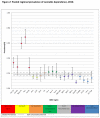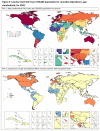The global epidemiology and contribution of cannabis use and dependence to the global burden of disease: results from the GBD 2010 study - PubMed (original) (raw)
Review
The global epidemiology and contribution of cannabis use and dependence to the global burden of disease: results from the GBD 2010 study
Louisa Degenhardt et al. PLoS One. 2013.
Erratum in
- Correction: The Global Epidemiology and Contribution of Cannabis Use and Dependence to the Global Burden of Disease: Results from the GBD 2010 Study.
PLOS ONE Staff. PLOS ONE Staff. PLoS One. 2016 Oct 19;11(10):e0165221. doi: 10.1371/journal.pone.0165221. eCollection 2016. PLoS One. 2016. PMID: 27760226 Free PMC article.
Abstract
Aims: Estimate the prevalence of cannabis dependence and its contribution to the global burden of disease.
Methods: Systematic reviews of epidemiological data on cannabis dependence (1990-2008) were conducted in line with PRISMA and meta-analysis of Observational Studies in Epidemiology (MOOSE) guidelines. Culling and data extraction followed protocols, with cross-checking and consistency checks. DisMod-MR, the latest version of generic disease modelling system, redesigned as a Bayesian meta-regression tool, imputed prevalence by age, year and sex for 187 countries and 21 regions. The disability weight associated with cannabis dependence was estimated through population surveys and multiplied by prevalence data to calculate the years of life lived with disability (YLDs) and disability-adjusted life years (DALYs). YLDs and DALYs attributed to regular cannabis use as a risk factor for schizophrenia were also estimated.
Results: There were an estimated 13.1 million cannabis dependent people globally in 2010 (point prevalence0.19% (95% uncertainty: 0.17-0.21%)). Prevalence peaked between 20-24 yrs, was higher in males (0.23% (0.2-0.27%)) than females (0.14% (0.12-0.16%)) and in high income regions. Cannabis dependence accounted for 2 million DALYs globally (0.08%; 0.05-0.12%) in 2010; a 22% increase in crude DALYs since 1990 largely due to population growth. Countries with statistically higher age-standardised DALY rates included the United States, Canada, Australia, New Zealand and Western European countries such as the United Kingdom; those with lower DALY rates were from Sub-Saharan Africa-West and Latin America. Regular cannabis use as a risk factor for schizophrenia accounted for an estimated 7,000 DALYs globally.
Conclusion: Cannabis dependence is a disorder primarily experienced by young adults, especially in higher income countries. It has not been shown to increase mortality as opioid and other forms of illicit drug dependence do. Our estimates suggest that cannabis use as a risk factor for schizophrenia is not a major contributor to population-level disease burden.
Conflict of interest statement
Competing Interests: The authors have declared that no competing interests exist.
Figures
Figure 1. Estimated prevalence (proportion) of cannabis dependence by age, sex and region, 2010.
Figure 2. Pooled regional prevalence of cannabis dependence, 2010.
Note. Prevalence estimates were standardised by population age and sex; AP-HI: Asia Pacific, High Income, As-C: Asia Central, AS-E: Asia East, AS-S: Asia South, A-SE: Asia Southeast, Aus: Australasia, Caribb: Caribbean, Eur-C: Europe Central, Eur-E: Europe Eastern, Eur-W: Europe Western, LA-An: Latin America, Andean, LA-C: Latin America, Central, LA-Sth: Latin America, Southern, LA-Trop: Latin America, Tropical, Nafr-ME: North Africa/Middle East, Nam-HI: North America, High Income, Oc: Oceania, SSA-C: Sub-Saharan Africa, Central, SSA-E: Sub-Saharan Africa, East, SSA-S: Sub-Saharan Africa Southern, SSA-W: Sub-Saharan Africa, West.
Figure 3. Global cannabis dependence DALYs (all YLDs) by age and sex, in thousands, 2010.
Figure 4. Country-level DALYs per 100,000 population for cannabis dependence, age-standardised, for 2010.
Note. Low: shows countries with statistically lower DALY rates than global mean; Middle: Shows countries with DALY rates that are not statistically different to global mean; High: Shows countries with statistically higher DALY rates than global mean.
Figure 5. The proportion of DALYs due to cannabis dependence relative to other substance use disorders in GBD 2010.
Note. Alcohol use disorders included alcohol dependence and foetal alcohol syndrome; Other drugs: Burden attributable to illicit drug types other than cannabis, opioid, amphetamine and cocaine dependence were estimated under residual categories in GBD 2010.
Similar articles
- The global epidemiology and burden of opioid dependence: results from the global burden of disease 2010 study.
Degenhardt L, Charlson F, Mathers B, Hall WD, Flaxman AD, Johns N, Vos T. Degenhardt L, et al. Addiction. 2014 Aug;109(8):1320-33. doi: 10.1111/add.12551. Epub 2014 Apr 24. Addiction. 2014. PMID: 24661272 - Global burden of disease attributable to illicit drug use and dependence: findings from the Global Burden of Disease Study 2010.
Degenhardt L, Whiteford HA, Ferrari AJ, Baxter AJ, Charlson FJ, Hall WD, Freedman G, Burstein R, Johns N, Engell RE, Flaxman A, Murray CJ, Vos T. Degenhardt L, et al. Lancet. 2013 Nov 9;382(9904):1564-74. doi: 10.1016/S0140-6736(13)61530-5. Epub 2013 Aug 29. Lancet. 2013. PMID: 23993281 Review. - Global burden of disease attributable to mental and substance use disorders: findings from the Global Burden of Disease Study 2010.
Whiteford HA, Degenhardt L, Rehm J, Baxter AJ, Ferrari AJ, Erskine HE, Charlson FJ, Norman RE, Flaxman AD, Johns N, Burstein R, Murray CJ, Vos T. Whiteford HA, et al. Lancet. 2013 Nov 9;382(9904):1575-86. doi: 10.1016/S0140-6736(13)61611-6. Epub 2013 Aug 29. Lancet. 2013. PMID: 23993280 Review. - Burden of disease due to amphetamines, cannabis, cocaine, and opioid use disorders in South America, 1990-2019: a systematic analysis of the Global Burden of Disease Study 2019.
Castaldelli-Maia JM, Wang YP, Brunoni AR, Faro A, Guimarães RA, Lucchetti G, Martorell M, Moreira RS, Pacheco-Barrios K, Rodriguez JAB, Roever L, Silva DAS, Tovani-Palone MR, Valdez PR, Zimmermann IR, Culbreth GT, Hay SI, Murray CJL, Bensenor IM. Castaldelli-Maia JM, et al. Lancet Psychiatry. 2023 Feb;10(2):85-97. doi: 10.1016/S2215-0366(22)00339-X. Lancet Psychiatry. 2023. PMID: 36697127 Free PMC article. - Global mortality, disability, and the contribution of risk factors: Global Burden of Disease Study.
Murray CJ, Lopez AD. Murray CJ, et al. Lancet. 1997 May 17;349(9063):1436-42. doi: 10.1016/S0140-6736(96)07495-8. Lancet. 1997. PMID: 9164317
Cited by
- The Lower-Risk Cannabis Use Guidelines (LRCUG): A ready-made targeted prevention tool for cannabis in New Zealand.
Fischer B, Daldegan-Bueno D, Bell R, Boden JM, Bullen C, Farrell M, Hall W, Newcombe D. Fischer B, et al. Public Health Pract (Oxf). 2020 Oct 29;1:100046. doi: 10.1016/j.puhip.2020.100046. eCollection 2020 Nov. Public Health Pract (Oxf). 2020. PMID: 36101675 Free PMC article. - The role of negative emotional reactivity and neighborhood factors in predicting marijuana use during early adolescence.
Tache RM, Rabinowitz JA, Gepty AA, Lambert SF, Reboussin BA, Reynolds MD. Tache RM, et al. J Adolesc. 2020 Dec;85:32-40. doi: 10.1016/j.adolescence.2020.09.002. Epub 2020 Oct 7. J Adolesc. 2020. PMID: 33038686 Free PMC article. - Prevalence of cannabis use among tobacco smokers: a systematic review protocol.
Skelton E, Rich J, Handley T, Bonevski B. Skelton E, et al. BMJ Open. 2022 May 2;12(5):e050681. doi: 10.1136/bmjopen-2021-050681. BMJ Open. 2022. PMID: 35501085 Free PMC article. - The prevalence and pattern of cannabis use among patients attending a methadone treatment clinic in Nairobi, Kenya.
Ngarachu EW, Kiburi SK, Owiti FR, Kangethe R. Ngarachu EW, et al. Subst Abuse Treat Prev Policy. 2022 Feb 15;17(1):12. doi: 10.1186/s13011-022-00437-7. Subst Abuse Treat Prev Policy. 2022. PMID: 35168646 Free PMC article. - Tolerance to WIN55,212-2 is delayed in desensitization-resistant S426A/S430A mice.
Nealon CM, Henderson-Redmond AN, Hale DE, Morgan DJ. Nealon CM, et al. Neuropharmacology. 2019 Apr;148:151-159. doi: 10.1016/j.neuropharm.2018.12.026. Epub 2019 Jan 8. Neuropharmacology. 2019. PMID: 30629988 Free PMC article.
References
- Gaoni Y, Mechoulam R (1964) Isolation, structure, and partial synthesis of an active constituent of hashish. J Am Chem Soc 86: 1646-1647. doi:10.1021/ja01062a046. - DOI
- Martin B, Cone E (1999) Chemistry and pharmacology of cannabis. In: Kalant H, Corrigal W, Hall W, Smart R. The Health Effects of Cannabis. Toronto: Addiction Research Foundation; pp. 19-68.
- Iversen LL (2000) The science of marijuana. Oxford University Press.
Publication types
MeSH terms
Grants and funding
Louisa Degenhardt is supported by an Australian National Health and Medical Research Council (NHMRC) Principal Research Fellowship. Wayne Hall is funded by an NHMRC Australia Fellowship. The National Drug and Alcohol Research Centre at the University of NSW is supported by funding from the Australian Government under the Substance Misuse Prevention and Service Improvements Grants Fund. Harvey A Whiteford and Alize J Ferrari are affiliated with the Queensland Centre for Mental Health Research, which receives its core funding from the Queensland Department of Health. Abraham D Flaxman, Theo Vos, Rebecca Engell, Greg Freedman and Christopher JL Murray received funding for their work on the Global Burden of Disease 2010 Study from the Bill and Melinda Gates Foundation. No funding bodies had any role in study design, data collection and analysis, decision to publish, or preparation of the manuscript.
LinkOut - more resources
Full Text Sources
Other Literature Sources
Medical




